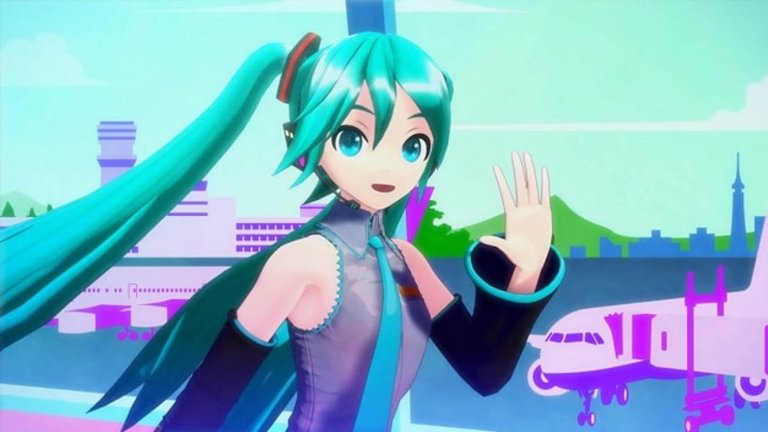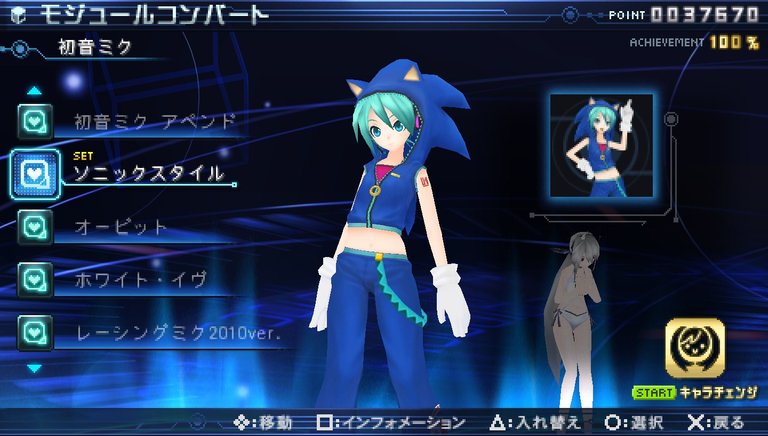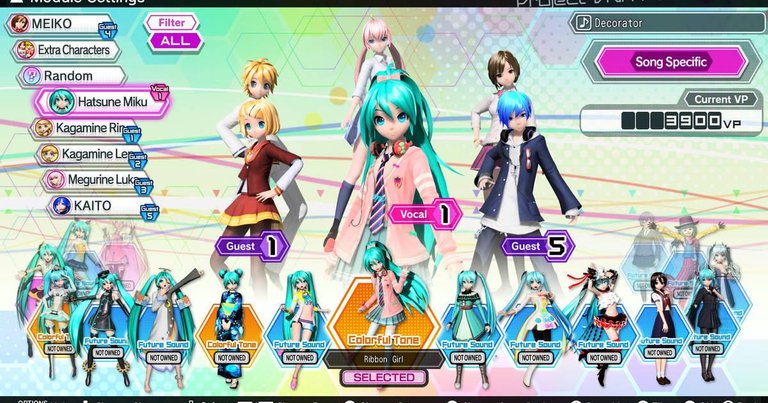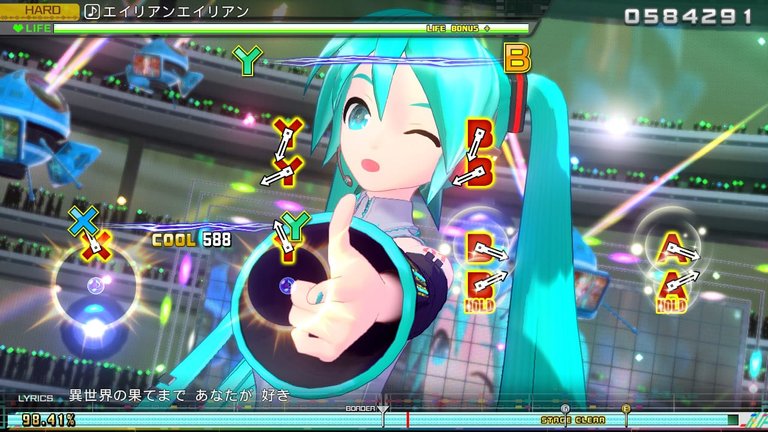English
English
Vocaloid is an audio synthesizer program in which different voice packages are used, mainly to create songs, but its possibilities are much broader.
Each voice pack has its own characteristics, as if they were different characters, as a result characters were created to represent each voice pack, but among them there is a girl of eternal 15 years: Hatsune Miku.

One of the first Vocaloids, and the most popular, with which more than 10,000 songs have been created, it would certainly be an impossible task to listen to all of them since different artists constantly resort to their voice package to compose songs of different genres. Commonly in Japanese and English, but you can also find songs in different languages.
Her fame was such that she is presented in concerts in the form of a 3D hologram, there is merchandise alluding to her, and it has her own video game franchise, which is what I come to talk about today.
Hatsune Miku: Project Diva is a series of arcade music video games that were initially only available in Japan for the PSP, later came to this part of the world for PS3, and since then multiple deliveries have been released on various consoles.
Despite the title, we will not only find songs by Miku, but also by other popular Vocaloids, such as Luka, the twins Rin and Len, Maiko, Kaito, among others.
Gameplay

As in the vast majority of music games, we must press the buttons that appear on the screen in a predefined order and to the rhythm of the song, sometimes we must press two buttons at the same time, and other times we will have to hold the button for long notes. In more recent games the use of joysticks and triggers for special notes is also added.
While we play, a kind of video will be played in the background alluding to the song we are playing at that moment, and this is where the customizable aspect of the game is found.

Although a song is sung by a certain Vocaloid, or by more than one, we can change those that appear while we play, this results in, for example, Miku singing with Luka's voice, or Rin with Kaito's, or an endless number of bizarre mixes we can do.
Apart from their traditional costumes they will have several additional ones, but undoubtedly it will be Miku who has the largest variety of costumes at their disposal, in more recent video games accessories can also be added to different parts of the body.
Initially there were only 3 difficulties, but throughout the different titles we can find up to 5, being these:
However, in most games we will only find 4 difficulties.
The difficulty is usually linked to the speed of each song, measured in "BPM", the higher the number, the more frenetic the rhythm of the song, and the greater its difficulty, a specific song stands out above all others for being the hell for any player.

Leaving the main section, the game comes with a level editor, so we can make our own versions of the songs that are included, apart from this, we can also customize our own choreography, these last two features being something that require a certain amount of time to learn how to use, and even more time to use them properly.
Also, each Vocaloid will have its own room, which we can personalize with objects that we buy in the store.
These additional features may vary between some games and others, personally I have only had the opportunity to complete those on PSP, and to play Project Diva F/F 2nd on PS3 a bit.
Although some of the screenshots that you can see are in Japanese, all the games launched outside of Japan will be in perfect English, however, if we only want to play the main mode, the language will not be any barrier, since with a little test and error we can find where everything is in broad strokes.
Soundtrack

Each game is made up mostly of some of the most famous themes of Miku and other Vocaloids, among the artists we can find several recognized among what Vocaloid is, such as DECO*27, wowaka, emon, Neru, ryo, and a long etc.
In each installment the number of songs usually varies, from an average of 40 in the Project Diva F, to more than 100 in the Project Diva Future Tone.
The variety of genres is wide,mostly J-Pop or electronic, so it will be a sure delight for those Vocaloid fans, although perhaps some would have preferred a more balanced number of songs, since almost all are usually by Miku, and a few others by Vocaloid, however this has been improved in recent titles with more variety.
In summary, Project Diva is a perfect franchise for those who love music video games, and also a good starting point for anyone interested in immersing themselves in the immense world of music composed with Vocaloid.
We are talking about certainly difficulty video games, however thanks to their different levels of difficulty it is accessible to even the least skilled in this genre.
And here ends today's post, as always thank you for reading this far, and also thank you very much for the support you show me through your votes and even comments, tell me about your experiences those who already know or have played any of the games of this great franchise.
Without much more to say, see you in the next post, bye bye.
PD: Hatsune Miku: Project DIVA Extend's screenshots were taken personally.
Español
Español
Vocaloid es un programa de edición de audio en el cual se utilizan diferentes paquetes de voz, principalmente para crear canciones, pero sus posibilidades son mucho más amplias.
Cada paquete de voz tenía sus propias características, como si se tratasen de diferentes personajes, a raíz de esto fueron creados personajes para representar a cada paquete de voz, pero entre todos ellos destaca una chica de eternos 15 años: Hatsune Miku.

Una de los primeros Vocaloids, y la más popular, con la cual se han creado más de 10.000 canciones, ciertamente sería una tarea imposible escucharlas todas ya que constantemente diferentes artistas recurren a su paquete de voz para componer canciones de diferentes géneros. Comúnmente en japonés e inglés, pero también se pueden encontrar canciones en diferentes idiomas.
Su fama fue tal que se presenta en conciertos en forma de holograma 3D, hay merchandising alusivo a ella, y tiene su propia franquicia de videojuegos, que es de lo que vengo a hablar hoy.
Hatsune Miku: Project Diva es una serie de videojuegos musicales arcade que inicialmente solo estaban disponibles en Japón para la PSP, posteriormente llegaron a esta parte del mundo para PS3, y desde entonces han salido múltiples entregas en varias consolas.
A pesar del título, no solo encontraremos canciones de Miku, sino también de otros Vocaloids populares, como Luka, los gemelos Rin y Len, Maiko, Kaito, entre otros.
Gameplay

Como en la gran mayoría de juegos musicales, deberemos presionar los botones que vayan apareciendo en pantalla en un orden predefinido y al ritmo de la canción, a veces deberemos presionar dos botones a la vez, y otras veces habrá que mantener el botón presionado para las notas largas. En juegos más recientes se agrega también el uso de los joysticks en los controles para notas especiales.
Mientras jugamos se reproducirá de fondo una especie de video alusivo a la canción que estemos jugando en ese momento, y es aquí donde se encuentra el aspecto personalizable del juego.

Aunque una canción sea cantada por un determinado Vocaloid, o por más de uno, podemos alterar los que aparecen mientras jugamos, esto resulta en, por ejemplo, Miku cantando con la voz de Luka, o Rin con la de Kaito, o un sinfín de mezclas bizarras que podemos hacer.
Aparte de sus trajes tradicionales tendrán varios adicionales, pero indudablemente será Miku la que tenga la más grande variedad de trajes a su disposición, en videojuegos más recientes también pueden agregarse accesorios a diferentes partes del cuerpo.
Inicialmente solo había 3 dificultades, pero a lo largo de los diferentes títulos podemos encontrar hasta 5, siendo estas:
Sin embargo en la mayoría de juegos encontraremos 4 dificultades solamente.
La dificultad suele estar ligada a la velocidad de cada canción, medida en “BPM”, mientras mayor el número, más frenético el ritmo de la canción, y mayor su dificultad, una canción en específico destaca por encima de todas las demás por ser el infierno para cualquier jugador.

Saliendo del apartado principal, el juego viene con un editor de niveles, por lo que podemos hacer nuestras propias versiones de las canciones que vienen incluidas, aparte de esto, también podemos personalizar nuestras propias coreografías, siendo estas dos últimas características algo que requieren una cierta cantidad de tiempo para aprender a utilizar, y aún más tiempo para utilizarlas adecuadamente.
También, cada Vocaloid tendrá su propia habitación, la cual podemos personalizar con objetos que compremos en la tienda.
Estas características adicionales pueden variar entre unos juegos y otros, personalmente solo he tenido la oportunidad de completar los de PSP, y de jugar un poco a los Project Diva F de PS3.
Aunque algunas de las capturas que pueden apreciar estén en japonés, todas las entregas disponibles fuera de Japón estarán en perfecto inglés, de cualquier forma, si solo queremos jugar al modo principal el idioma no será ninguna barrera, ya que con un poco de ensayo y error podemos hallar donde está cada cosa a grandes rasgos.
Soundtrack

Cada juego se compone en su mayoría de algunos de los temas más famosos de Miku y otros Vocaloids, entre los artistas podremos encontrar a varios reconocidos entre lo que es Vocaloid, como DECO*27, wowaka, emon, Neru, ryo, y un largo etcétera.
En cada entrega el número de canciones suele variar, desde un promedio de 40 en los Project Diva F, hasta más de 100 en Project Diva Future Tone.
La variedad de géneros es amplia, por lo que será un seguro deleite para aquellos fans de los Vocaloid, aunque tal vez algunos hubieran preferido una cantidad de canciones más balanceada, ya que casi todas suelen ser de Miku, y unas cuantas de otros Vocaloid, sin embargo esto se ha ido mejorando en títulos recientes con más variedad.
En resumen, Project Diva es una franquicia perfecta para aquellos amantes de los videojuegos musicales, y también un buen punto de partida para quien esté interesado en sumergirse en el inmenso mundo de la música compuesta con Vocaloid.
Hablamos de videojuegos con una dificultad ciertamente complicada, sin embargo gracias a sus diferentes niveles de dificultad resulta accesible hasta para el menos diestro en este género.
Y hasta aquí llega el post de hoy, como siempre muchas gracias por leer hasta aquí, y también muchísimas gracias por el apoyo me demuestran a través de sus votos y hasta comentarios, cuéntenme sus experiencias aquellos que ya conozcan o hayan jugado alguno de los juegos de esta genial franquicia.
Sin mucho más que decir, nos vemos en el próximo post, bye bye.
PD: Las capturas de Hatsune Miku: Project DIVA Extend fueron tomadas personalmente